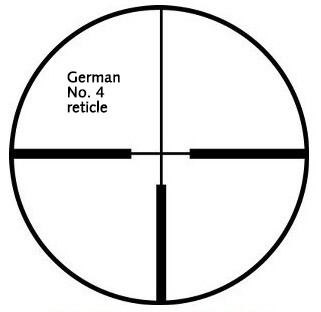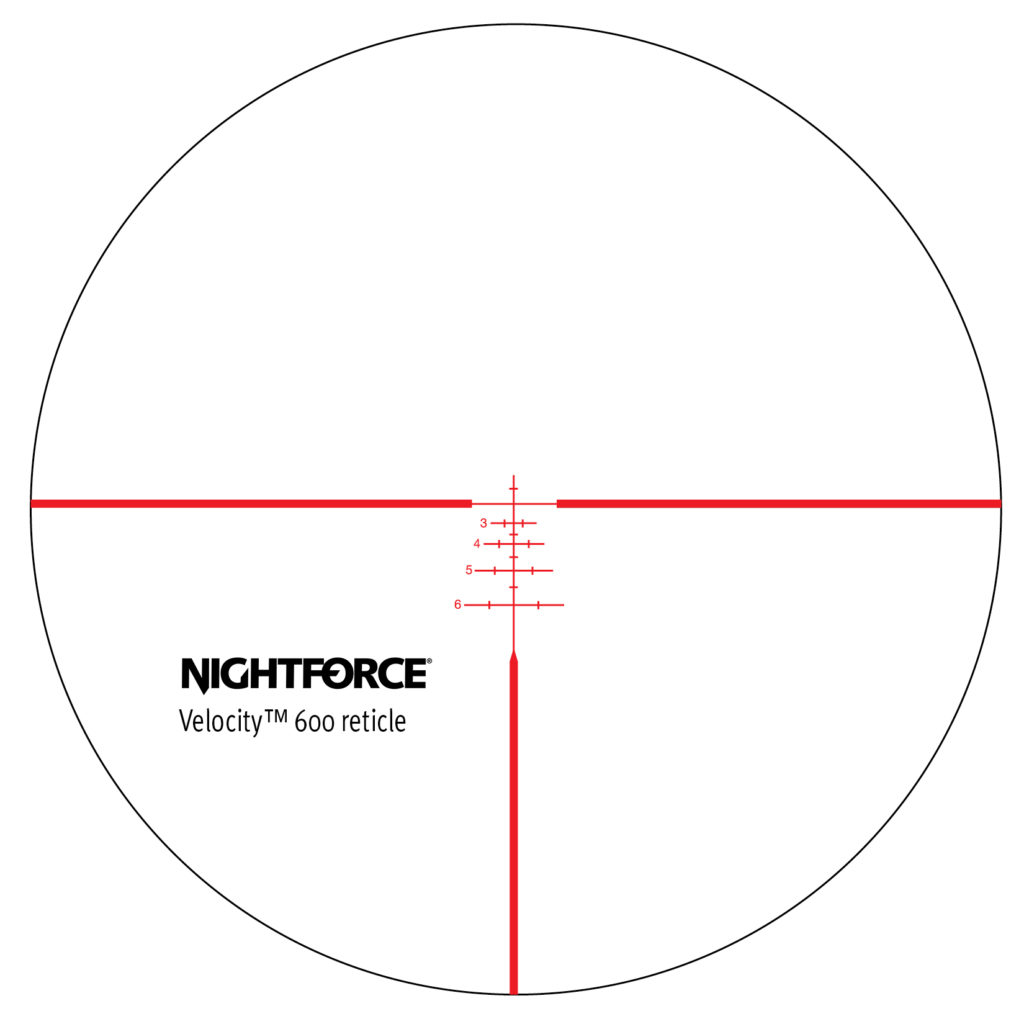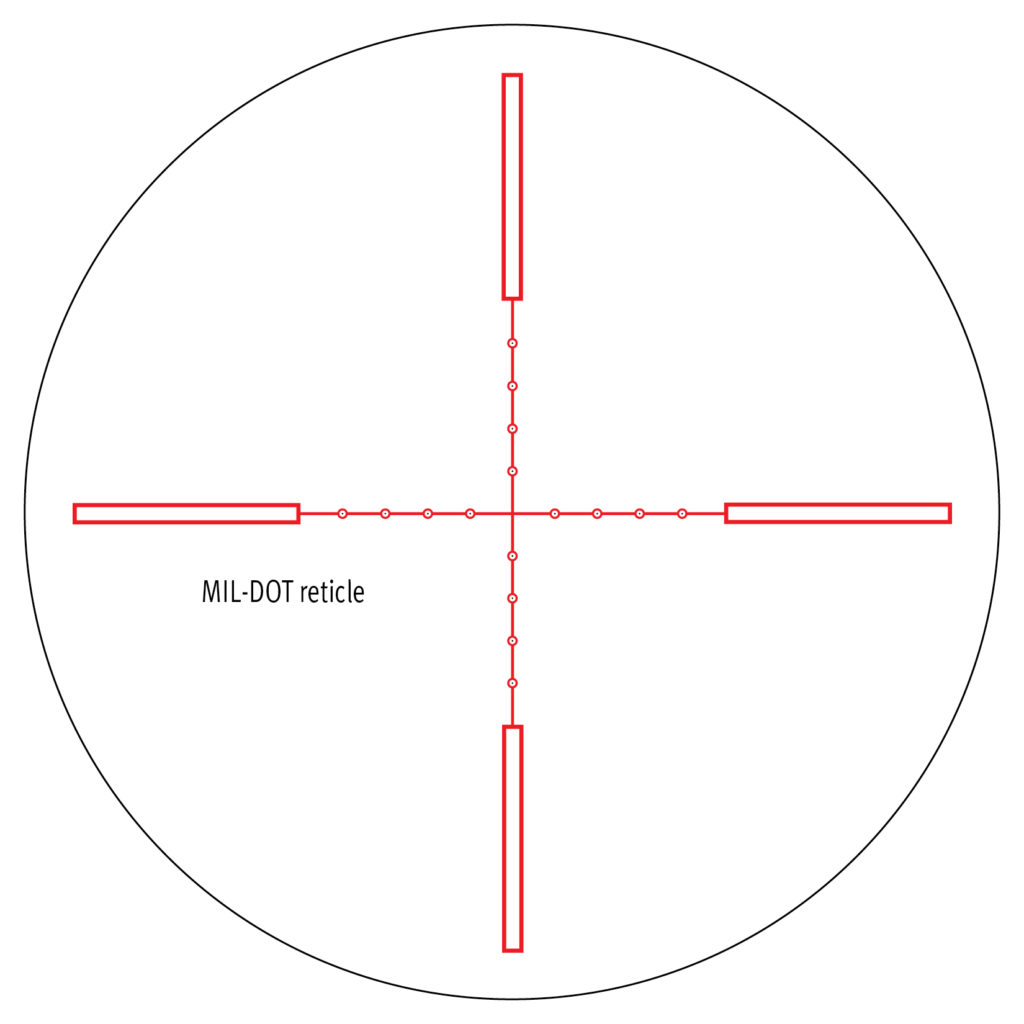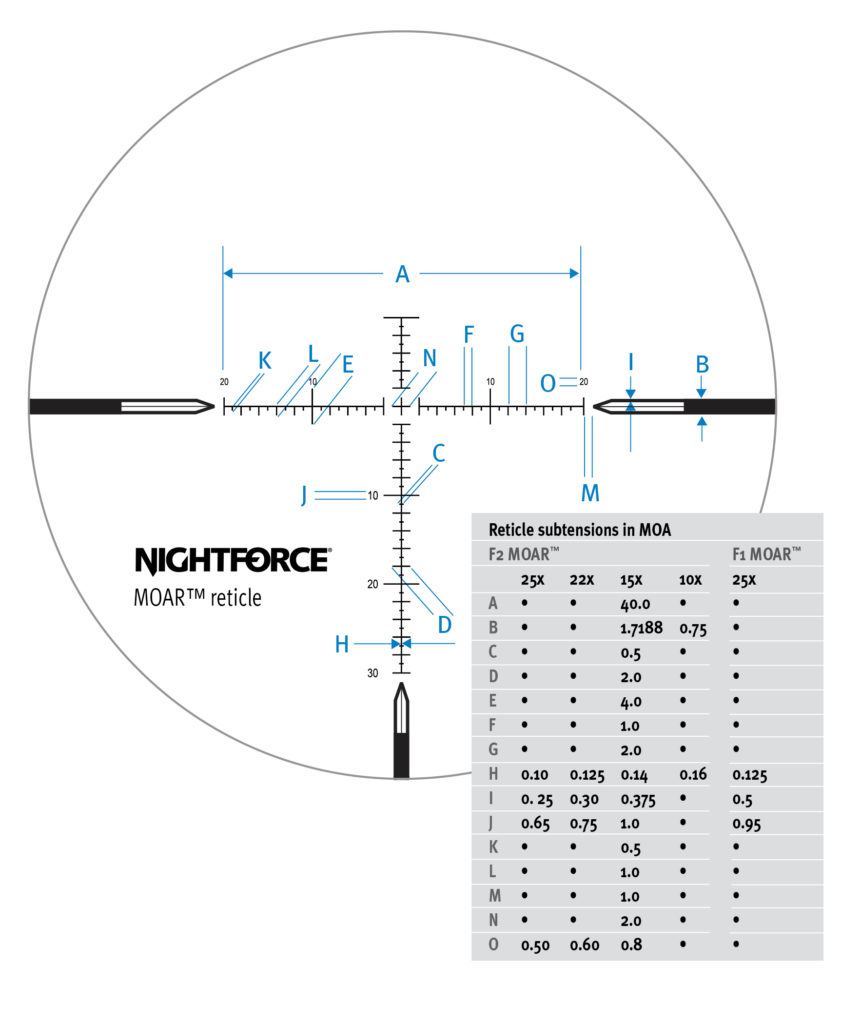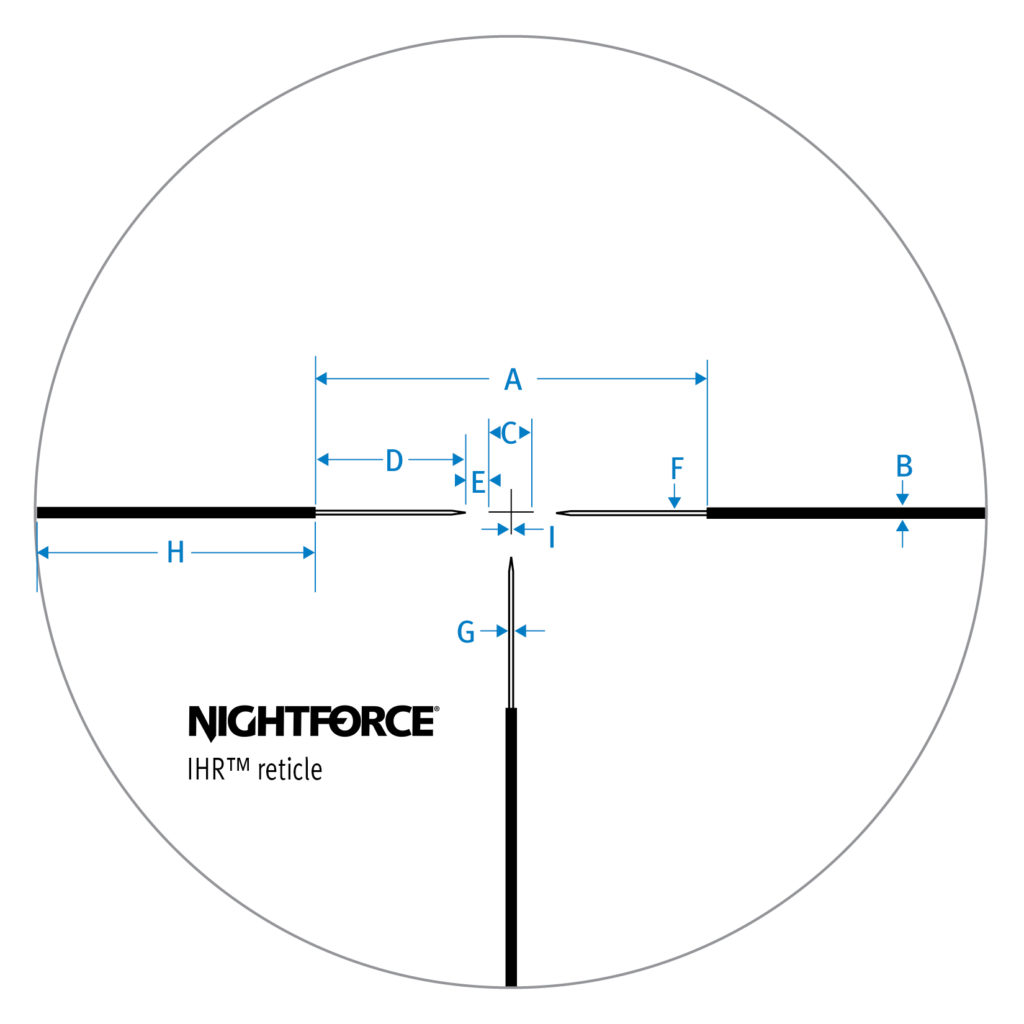“Sorting through the styles, the choices and the marketing hype to choose an effective hunting reticle.”
Last month we looked at the development of the modern riflescope reticle, focal planes, MOA vs. Mil-Radians, and the pros and cons of illuminated reticles. This time, we’re going to take a hard look through the viewfinder at the characteristics that make a good hunting reticle, versus one you might come to regret.
Styles of Reticles
[column size=one_half position=first ]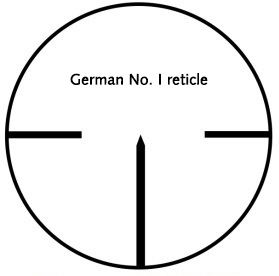
Post and Crosshair
First, there were simple crosshairs, which provided an aiming point but little more. The Europeans were the first to experiment with modifications, the simplest being the addition of heavier posts, usually at the 3, 6 and 9 o’clock positions. These posts tend to draw the eye to the center of the reticle, with nothing to clutter the sight picture, and such designs remain extremely popular today. They are especially useful for running and/or dangerous game applications, where quick shots can be required. With the European love for hunting driven boar, usually at close ranges, you can see why such designs—sometimes called “duplex” or “post and crosshairs”—evolved. The German No. 4 reticle remains the most popular all-around reticle in most of Europe. There are better choices, though, for mountain hunting, which usually involves longer ranges and more deliberate, carefully considered shots.
Ballistic Reticles
There is a dizzying array of choices that can be grouped under the broad (and often misleading) heading of “ballistic” reticles. In simplest terms, this means adding markings to a reticle that in some way tie into the inherent ballistics of a rifle and its cartridge, providing you with holdover points and/or rangefinding information.
When I learned to shoot, basic crosshairs were about the only choice. We sighted in a rifle “a couple of inches high at 100” and assumed that we would be more or less on target (if the target was pretty large) out to 250 or 300 yards. This is still the technique used by vast number of casual hunters, but it is like using a rotary dial phone when you can have an iPhone instead. They both work, but one does the job a lot more elegantly.
The purpose, both of the “couple inches high” theory and of a ballistic reticle, is to compensate for the effects of gravity. As with Isaac Newton’s apple, a bullet fired from a rifle will eventually fall to the ground. The goal is to eliminate the need to estimate holdover and to dispense with guessing, which more often than not results in a miss.
Some reticles accomplish this goal extremely well. Those are the exceptions. The truth of the matter is that far too many “ballistic” reticles are marketing gimmicks, overly complicated, completely impractical, or all of the above. Do not get taken in by exaggerated advertising claims.
Early attempts at compensating for a bullet’s inherent downward trajectory required you to know things like the chest-to-shoulder height of a given game animal, or even more absurd, the size of its antlers or horns. Align the reticle markings accordingly, and you will instantly know the range and where to aim. Right. This might work if you only hunt one type of game, and if every one of its species is exactly the same size. It also helps if you have several minutes to do all this, and your target doesn’t move. Thankfully, most of these creations have gone by the wayside, but a few still persist. Avoid them. Please.
Another type of design, sometimes referred to as BDC (bullet drop compensating), incorporates lines, circles, dots, or other such markings on the vertical scale of a reticle that are intended to provide holdover points at various ranges. Do they work? Some do. Many don’t. What I can guarantee is that virtually none of them will work right perfectly right out of the box, and you will have some homework to do to make them perform as intended.
Such reticles are tied to the ballistics of your rifle and the trajectory of your load. Published ballistic charts and tables are only estimates, and if you take them as gospel you will be disappointed. There are so many variables—bullet design and ballistic coefficient, bullet weight, powder, case, primer, barrel length, and more—it is unrealistic to expect an off-the-shelf reticle of this design to be right on target, literally or figuratively. Even the exact same cartridge of the same caliber will shoot to different points in different makes of rifles.
Does this mean that drop-compensating reticles are ineffective? No. What it means is that the only way to confirm indicated holdover points is by live firing at the range at each marked distance. Being inherently lazy, I’d love to put a shiny new riflescope on one of my rifles with complete confidence that it will shoot exactly where the markings say, with no effort on my part. For that matter, I’d like to win the lottery, too. Unfortunately, there is no such thing as “one size fits all.”
One of the more effective ballistic systems I’ve seen consists of the Nightforce Velocity™ 600 and Velocity™ 1000 reticles. The 600 is designed for accurate shot placement to 600 yards; the 1000 adds more holdover markings for ranges to 1000 yards.
There are multiple versions offered of each reticle, the only difference being the distance between the holdover marks. Nightforce found that virtually every known rifle caliber matches almost perfectly with one of just a few reticle configurations. The concept is based upon the bullet weight, the bullet’s ballistic coefficient, and above all, the muzzle velocity of a given load. The validity of this approach was proven to me when I ran the ballistic information on two radically different calibers of mine through Nightforce’s online calculator: a .30-06 shooting a 180-grain bullet at 2750 fps, and a .330 Dakota firing a 250-grain bullet at 2765 fps. No way, I thought, that the same holdover markings would apply to a 180-grain and 250-grain bullet. But they did. The same Velocity™ 600 MV (medium velocity) works admirably for both, with minimum deviation from the reticle’s standard markings.
For reference, see the “Velocity Reticle Calculator 7000ft” chart, which was generated for my .30-06. While a 200-yard zero is standard for the center point of a Velocity 600 reticle, in this case, Nightforce recommended a 205-yard zero. This minimizes any deviation from the reticle’s holdover markings across the entire 600-yard trajectory. For example, if I hold at the 300-yard mark, my bullet will hit 0.4076 inches low. At 400 yards, 0.8793 inches low. At 500 yards point of impact is 1.0042 inches low, and at 600 yards, I am only 0.0511 inches low.
So, the maximum deviation from the reticle’s indicated distance markings at any point out to 600 yards is a mere 1 inch. Maximum deviation using the same reticle on my .330 was 1.6411 inches, at 500 yards. I can certainly live with that in a hunting environment.
One real advantage of such a system is that it is quick, and we all know that speed is often of the essence when hunting. If you know the range to a target, you simply choose the proper holdover marking, aim dead on and fire. There are no calculations, no charts to consult, no guessing. The reticle is relatively uncluttered and applicable to just about any hunting environment, with the possible exception of dangerous game.
It is imperative, though, that with such a system you must use real-world muzzle velocity figures, determined by a chronograph. That is the only way to ensure precise point of impact at various ranges.
It works. I’ve dropped an elk at 550 yards, and put a bullet through a six-inch opening at just under 300 yards, due entirely to the reticle, not to my shooting prowess. This was only possible after confirming its performance at the range.
The bottom line? Ballistic reticles can be extremely useful for the mountain hunter, if a few conditions are met:
- The reticle must not be overly cluttered or complicated.
- It must do its job quickly and with a minimum of thought.
- Its markings and promised performance must be matched as closely as possible to your rifle and your load.
- You must verify all reticle markings—and advertising claims—through live firing at multiple distances.
Dots, Hash marks, Stadia and Subtensions
It should be no surprise that tactical and military professionals were instrumental in driving the development of effective ballistic reticles, and one of the earliest and most successful designs is the Mil-Dot. The first practical application of the Mil-Dot reticles was in the Unertl 10x fixed-power riflescopes used by the U.S. Marine Corps snipers from WW II through the Vietnam War. They provide reliable range estimating as well as accurate elevation and windage holds. They are based on the mil-radian system of metric measurement, one mil being equal to 10 centimeters at 100 meters.
The Mil-Dot reticle laid the groundwork for most truly effective ballistic designs that followed, due to its markings and line widths being universally consistent. For example, the distance between each dot is precisely one mil at 100 meters. The dots themselves are .25 mil in diameter. Each line thickness and distance between points also has a specific measurement in mils or fractions of mils.
The Mil-Dot reticle allows the shooter to accurately estimate distance to target—in meters or yards—by knowing the size of the target and applying it to a mathematical formula. This would, in turn, tell the shooter precisely which dot to use for elevation holdover and windage compensation.
Mil-Dot reticles remain extremely popular with military and law enforcement professionals as well as with accomplished civilian shooters. “Accomplished” is the key word, though. The Mil-Radian system of measurement (see Part One of this article), while extremely accurate, requires a lot of time to master, and quick and effective use of the reticle itself demands a good amount of training and practice.
Since math and I never got along, I prefer the minute-of-angle (MOA) system of measurement—similar in application to mil-radians, but easier for me to comprehend since it is based on inches and yards. One MOA is 1.047 inches at 100 yards—we’ll call it an even one inch for simplicity. Two MOA is approximately two inches at 200 yards, three inches at 300 yards, and so on. The markings on an MOA-based reticle, properly known as stadia, correspond to minutes of angle or fractions thereof. The spacing/thickness of the markings are called “subtension.” The reticle subtends to a different measurement at every range.
This sounds more complicated than it really is. Let’s say your rifle shoots 16 inches low at 400 yards. At 400 yards, one MOA equals approximately four inches. So, assuming you have zeroed your scope at 100 yards, you would use the four-MOA mark below centerline to hold on your target and this would provide the necessary 16 inches of elevation.
We have to remember, though, that depending upon the scope, subtensions can vary according to magnification settings. And, if you intend to use an MOA reticle for rangefinding (target size in inches, divided by MOA times 100, equals range to target in yards), it is only accurate at a specific magnification setting, usually marked on the riflescope. While laser rangefinders have reduced the need to estimate range with a reticle, it is still a useful technique to know.
So, is an MOA- or mil-radian-based ballistic reticle a good choice for mountain hunting? Absolutely, under certain conditions. If you expect to regularly encounter long shots, say 400 yards and beyond, it is the quickest and most precise means of applying an accurate holdover (and windage compensation, if necessary). It is also an excellent choice for smaller targets. There is, though, a substantial learning curve, and you will want to spend a lot of time at the range. A good ballistic reticle is a remarkable tool, but on the side of a mountain in fading light is not the time you want to figure out how to use it.
The Best of Both Worlds?
If you find yourself occasionally hunting running game, if you rarely take shots much over 300 yards, if you at times hunt in thick cover, or if you simply prefer a less complicated, more traditional reticle, that brings us full circle back to the traditional post and crosshairs design. That doesn’t mean you have to go back to guessing, though, as a number of newer such reticles have been engineered to provide accurate holdover and windage reference points in a simple, uncluttered design.
One of my favorites is the IHR™ (International Hunting Reticle), a Nightforce creation. Note the measurements in the subtension diagram. The floating center crosshair (C) is precisely six MOA in width and height. The distance from the crosshair to the thin open posts (E) is exactly three MOA. If you needed six MOA of elevation, for example, to compensate for bullet drop over a long distance, if you held on your target at the tip of the thin post below centerline, that is what you would get (one-half the height of the floating crosshair = three MOA, plus the open space below it, an additional three MOA).
All markings on this deceptively simple design are directly related to MOA. The D measurement, for example, is 20 MOA. H is 37 MOA. The thickness of the heavy posts, B, is 1.5 MOA.
Six MOA at 500 yards, by the way, is approximately 30 inches, pretty close to the drop of a .300 Win Mag at that distance. Your mileage may vary, but you can see that memorizing just a few of the subtensions in this reticle would give you some rather precise reference points for elevation and windage compensation. It sure beats guessing, and it’s a lot quicker than consulting a drop chart or trying to estimate the size of your target in the field. Plus, these simple calculations can be performed without having to take your eye off of your target.
No, it’s not as precise as a detailed MOA or Mil-Radian reticle, but it results in a reticle that’s just as effective on a deer in the woods as on a sheep a mountaintop away. Most manufacturers should publish, or can provide you with, their reticle MOA subtensions. If they cannot, I suggest finding a different manufacturer.
More Questions… and Answers
Using a borrowed rifle and scope once cost me a nice muntjac during a hunt in England. The muntjac is a small deer that stands about 20 inches high at the shoulder. The reticle I was using was so thick it resembled crossed two by fours. It would have been fine for a big wild boar being driven through the woods, but at 300 yards it completely covered the tiny animal. Shot placement? I couldn’t even see where I would have placed a shot.
Conversely, an extremely thin reticle, such as those preferred by varmint hunters and competition shooters, who are concerned with fractions of an inch, are often too fine for big game applications. They can easily disappear against the body of a dark animal and are difficult to see in low light or thick cover.
Like Goldilocks, you are looking for one that is just right. It must be thick enough to see easily, but not so thick that it obscures your target.
A reticle should be specifically tailored to the scope you choose, too. A reticle designed for maximum performance in a high-magnification riflescope, for example, a 5-25x model, will generally not provide good results in a 2.5-10x riflescope, and vice versa.
Buying a good riflescope/reticle combination is a substantial investment. If your friendly local dealer will allow it, I highly recommend test-driving a reticle/scope combination for a few days before plunking down a pile of cash. Take it home and see how it looks at dawn and dusk, not just at midday. Try it on neighborhood dogs and cats (not mounted on a rifle, please) at close distances and at long ranges, to get an idea of how it looks against an animal. Bring it to your eye quickly and make sure it works well with your vision. If it has rangefinding and/or holdover capabilities, make sure you are comfortable with them, that they are not overly complex, and that they will help, not hinder your hunting style.
If you can’t borrow the scope/reticle for a test drive, at the very least, call the customer service department of the scope manufacturer you are considering. Tell them about you, about your rifle, and about your hunting style, and ask for recommendations. They should be more than willing to talk hunting with you. If you perceive that the person on the other end of the line is not a hunter, or is reading to you from a catalog, I suggest considering another brand.
Wrestling with Reticles
We hunters are fond of spending long hours debating the merits of one caliber over another. We’ll spend years saving for a fine custom rifle. We’ll devour every written word on a new riflescope. But how often have you heard a spirited discussion around the campfire about a reticle? This is unfortunate, because ultimately, it is the reticle that allows you to translate all the potential of rifle, cartridge and optics into an accurate shot on your target.
Next time you’re in the market for a new scope, give some thought to your reticle, too. Just don’t make it an afterthought.
About the Author:
Tom Bulloch has worked in the optics industry for over 21 years. He has hunted on six continents, doing, as he puts it, “more hunting for less money than any man alive.”
His credentials as a mountain hunter include two ibex, bighorn and Dall sheep, a mountain goat, tahr, chamois, mouflon, and many timberline elk and mule deer. He lives at nearly 9000 feet in the Colorado Rockies, where, he says, “even looking for my car keys is a mountain hunt.”


